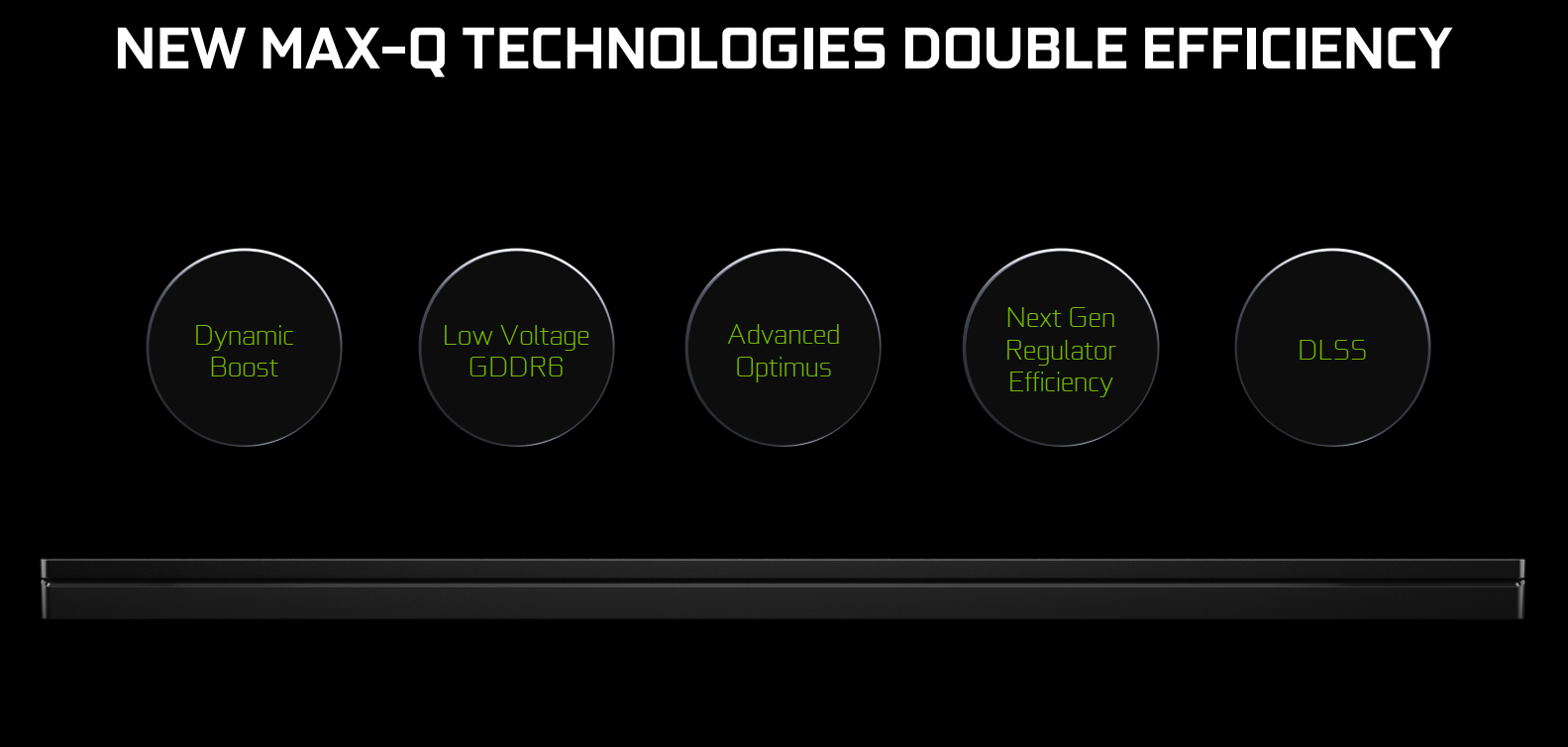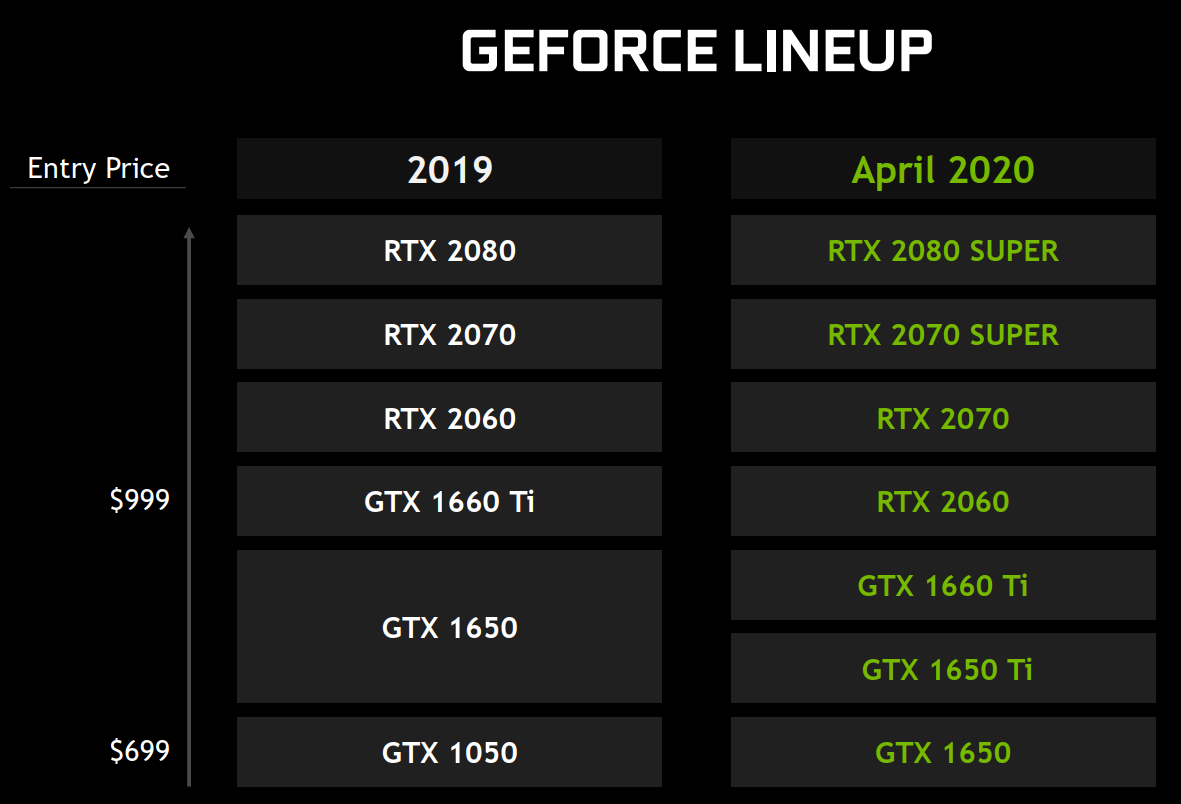Nvidia Brings Its Super Game to Laptops: RTX 2080, 2070 Super, Along With Improved Max-Q
It’s a big day for gaming laptops. Intel is taking the official wraps off its 10th Gen H-Series processors (countering AMD’s impressive new Ryzen 4000 chips). And Nvidia is finally bringing its Turing-based Super cards to laptops, in the form of the new RTX 2080 Super and RTX 2070 Super.
Not content to just deliver new silicon to the portable gaming space, Nvidia is also offering up improvements to its laptop-slimming Max-Q tech, as well as finally bringing power-saving Optimus Technology support to systems with screen-smoothing G-Sync displays. But first, let’s take a look at the specs for Nvidia’s new laptop lineup:
| GeForce RTX 2080 Super | GeForce RTX 2070 Super | GeForce RTX 2070 | GeForce RTX 2060 | GeForce RTX 1660 Ti | GeForce RTX 1650 Ti | GeForce RTX 1650 | |
|---|---|---|---|---|---|---|---|
| Nvidia CUDA Cores | 3072 | 2560 | 2304 | 1920 | 1536 | 1024 | Up to 1024 |
| Boost Clock | 1080-1560 MHz | 1155-1380 MHz | 1125-1455 MHz | 1185-1560 MHz | 1335-1590 MHz | 1200-1485 MHz | 1125-1560 MHz |
| Memory Configuration | 8GB DDR6 | 8GB DDR6 | 8GB DDR6 | 6GB DDR6 | 6GB DDR6 | 4GB DDR6 | 6GB DDR6, 4GB DDR5 |
| Memory Interface Width | 256-bit | 256-bit | 256-bit | 192-bit | 192-bit | 128-bit | 128-bit |
| Memory Bandwidth (GBps) | Up to 448 GBps | Up to 448 GBps | Up to 448 GBps | Up to 336 GBps | 288 GBps | Up to 192 GBps | Up to 192 GBps |
| Total Graphics Power (TGP, W) | 80-150+ W | 80-115 W | 80-115 W | 65-115 W | 60-80 W | 35-55 W | 30-50W |
One thing to notice here is that Nvidia has dropped the mobile RTX 2080 from the list, as it largely overlaps the new 2070 Super. The mobile RTX 2070 and 2060 remain, however, along with the other Turing GTX GPUs.
Alongside the new GPU SKUs, Nvidia is launching some advancements to its Max-Q technology, with a focus on efficiency. These include a more dynamic sharing of available thermals (a laptop’s ability to dissipate heat created by the CPU and graphics silicon) that the company calls Dynamic Boost. This lets the graphics card consume more power (thus boosting performance) when the full muscle of the CPU isn’t necessary (which often happens during gaming, particularly on CPUs with lots of cores and threads).
Intel and AMD have talked about this as well, as making the most of the available power is crucial in a laptop. AMD's SmartShift technology, which is also in the PlayStation 5 (and possibly Xbox Series X, though we don't have confirmation on that yet), helps to improve overall gaming performance in a similar fashion. For its part, Intel has had various forms of dynamic power allocation for a while, but not at a system level. Intel has hinted that it will be doing more with dynamic power balancing in hardware with its Xe Graphics and Tiger Lake, but it hasn't provided details yet.
Perhaps the most enticing improved feature for those who like to do things with their laptop other than game — and often when unplugged — is an update to the company’s Optimus tech, which switches over to integrated graphics when not handling GPU-intensive tasks (like sitting at the desktop or working on most productivity tasks).
Optimus has been around a little over a decade, but has never supported G-Sync displays before, thus shortening battery life for an increasing number of gaming-focused laptops over the years. Now new laptops will support both Optimus and G-Sync (up to 4K and 120Hz) so you can finally get good battery life while not gaming and smooth variably refreshed frames when you are. And for those seeking to improve battery life when gaming and away from a power plug, Nvidia says its machine-learning-assisted upscaling DLSS feature (now DLSS 2.0) can improve battery life by up to 20%.
Get Tom's Hardware's best news and in-depth reviews, straight to your inbox.
In all, Nvidia says its Max-Q improvements double efficiency. Just note that to make that claim, the company is comparing a brand-new 2080 Super-equipped laptop to a three-year-old comparison model with a GTX 1080, and it's not clear if DLSS 2.0 is involved in the above slide. So those efficiency gains likely come from more than just Max-Q-related tweaks.
Much like when Super arrived in desktop cards, this refresh should deliver more performance per dollar. Nivida says GTX 1650 laptops will now start as low as $699, with RTX 2060 laptops starting at $999. Here’s how Nvidia sees pricing playing out now versus in 2019.
Every tier of the laptop spectrum basically gets a 10-20% boost in performance with the 2020 updates. Combined with the new features and the launch of AMD's Ryzen 4000 and Intel's 10th Gen H-series mobile CPUs, 2020 looks to be a great time to upgrade to a new laptop. The Asus Zephyrus G14 is the first of what will likely be many new additions to our list of the best gaming laptops.
After a rough start with the Mattel Aquarius as a child, Matt built his first PC in the late 1990s and ventured into mild PC modding in the early 2000s. He’s spent the last 15 years covering emerging technology for Smithsonian, Popular Science, and Consumer Reports, while testing components and PCs for Computer Shopper, PCMag and Digital Trends.
-
mcilieg Reply
Gtx? I thought it should be RTX, no?admin said:Nvidia’s GTX 2080 Super and GTX 2070 Super finally land in laptops, alongside improvements in Max-Q and Optimus that finally works in tandem with G-Sync.
Nvidia Brings Its Super Game to Laptops: GTX 2080, 2070 Super, Along With Improved Max-Q : Read more





